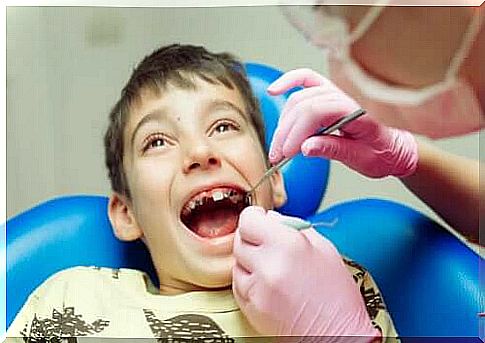The Most Common Dental Problems Among Children

There are some typical children’s dental problems that are very common, but we can almost always prevent them. When they appear, the normal functions of the mouth (such as chewing, speaking and swallowing) are altered.
In the following lines we will talk about the most common dental problems in children, the causes of each of them and the most suitable treatment. Finally, we will review what to do to ensure your baby’s mouth is always healthy.
The most common dental problems among children

Caries
Among the various dental problems in children, this is the most common one. It consists in the loss of mineral tissue by the dental elements, due to the action of the acids produced by the bacteria present in the mouth.
In the initial phase, small white spots are noted on the tooth surface. Subsequently, the tooth begins to show a black or brown discoloration, as well as a loss of tissue. In addition, holes and cavities form on the teeth.
As we said, the loss of the minerals that make up the dental element occurs due to the action of the acids produced by the bacteria present in the mouth, when the sugars of the ingested foods ferment. Poor oral hygiene and high sugar consumption predispose to the development of this condition.
There is a particular type of caries typical of younger children, called “early childhood caries” or “bottle caries”. It is associated with the habitual consumption of sweetened milk and the lack of hygiene after a meal. The accumulation of sugar on the surface of the teeth favors the appearance of these caries, which progress rapidly, especially on the front teeth.
Consequences of this dental problem in children
The presence of caries and their evolution in the absence of surgery, involves complications in the life of the little one:
- Presence of pain: due to the increase in depth of the lesion, the caries approaches the dental pulp, where the nerves are located, causing sensitivity and pain.
- Destruction and loss of the tooth. As the lesion progresses, the tooth wears out and can even break. In addition, it can result in the movement of adjacent teeth, malocclusion and problems associated with the act of biting.
- Infections: caries can lead to infection of the tooth or of the hard or soft tissues adjacent to the affected element.
- Permanent damage to the tooth : when, that is, the caries advances on a temporary element, it can interfere with the correct formation of the final tooth that is located below.
- Low self-esteem and social problems. In fact, broken and stained teeth can be a reason for ridicule, to the point of making the child suffer.
Treatments for dental caries
The type of treatment to reverse the caries depends on its size and evolutionary stage. Early stage caries can be treated with the therapeutic application of fluoride. As for cavities with cavities and tissue loss, then it will be necessary to clean and rebuild with fillings.
Regardless of the type of caries, it is always important to intervene to stop its evolution and avoid complications.
Dental trauma
Undergoing dental trauma is another of the most common dental problems among children. It usually occurs when the little ones start walking, and therefore it is associated with accidents during a moment of play or during sports practice. The teeth most often affected are the upper incisors, because they are the most exposed.
Trauma can affect both milk and permanent teeth. It can be a partial or total rupture of the dental crown, a displacement of the same or even its expulsion from the mouth.
The measures to be taken will depend on the type of tooth affected, but the best thing to do, in the face of any trauma to the mouth, is to contact the dentist immediately. In the event that the tooth has been expelled from the mouth, it must be searched for and transported by immersing it in milk or physiological solution.
The professional will examine the affected tissues and decide on the most appropriate treatment: from a simple application of fluoride and checkups, reconstructions or fillings, to a devitalization, up to the replacement of the tooth and fixing with braces. As we said, it is important to contact the dentist urgently, since the faster we act, the better the prognosis.
Malocclusions
Misaligned teeth and difficulty biting are usually common dental ailments among children. Observing the position of the teeth as they emerge, and the correspondence between the teeth of the upper arch and those of the lower arch during the bite is important to identify any anomaly in the dental occlusion of the youngest.
Monitoring the situation at home and referring the child to dental check-ups helps to discover these problems in time. The earlier you begin to cope, the easier and less annoying the treatment will be.
These types of dental disorders in children can be caused by several factors:
- Presence of dysfunctional habits, such as finger sucking, prolonged use of a pacifier or bottle, and oral breathing.
- Premature absence or loss of baby teeth.
- Hereditary and genetic factors.
- Bruxism.
Treatment will depend on the type and severity of the malocclusion, as well as the age of the child and the type of teething in his mouth. Depending on the case, you can intervene to correct, with the application of orthopedic appliances, fixed orthodontic appliances, with dental appliances or through the application of invisible orthodontics.

Gingivitis
The presence of bacterial plaque around the tooth can promote inflammation of the gums. The latter will turn red, bleed easily, hurt; in addition, bad breath is present in these cases.
The cause of this dental disorder in children is poor oral hygiene. Brushing and flossing, as well as consulting a pediatric dentist, are usually sufficient to treat this problem.
How to avoid the most common dental problems in children?
Following good oral hygiene and healthy habits will help preserve mouth health. Here are some tips for preventing dental disorders in children:
- Maintain good oral hygiene: Brush children’s teeth two or three times a day, with a soft-bristled toothbrush and fluoride toothpaste. Complete with dental floss to be used every day and, with the permission of the dentist, proceed with rinsing.
- Avoid cariogenic foods. Limit or eliminate the consumption of foods that are high in sugar. It is advisable to give the little ones a diet rich in nutrients and varied.
- Eliminate harmful habits: those of babies sucking their thumbs, biting their nails, breathing with their mouths, using pacifiers or bottles longer than expected. In these cases, it is necessary to seek help to eliminate these harmful habits for the mouth.
- Consult the dentist : subjecting your baby to early checkups helps to preserve the health of the mouth. The professional will be able to identify the problem in time and give indications for the care of the mouth.
It is possible to prevent dental problems in children
Dental problems in children can appear from an early age. There are various pathologies that affect the mouth of the little ones and a healthy mouth is important for the little ones to grow well.
As a result, proper oral hygiene, healthy habits, and regular visits to the dentist will help maintain a healthy smile.









